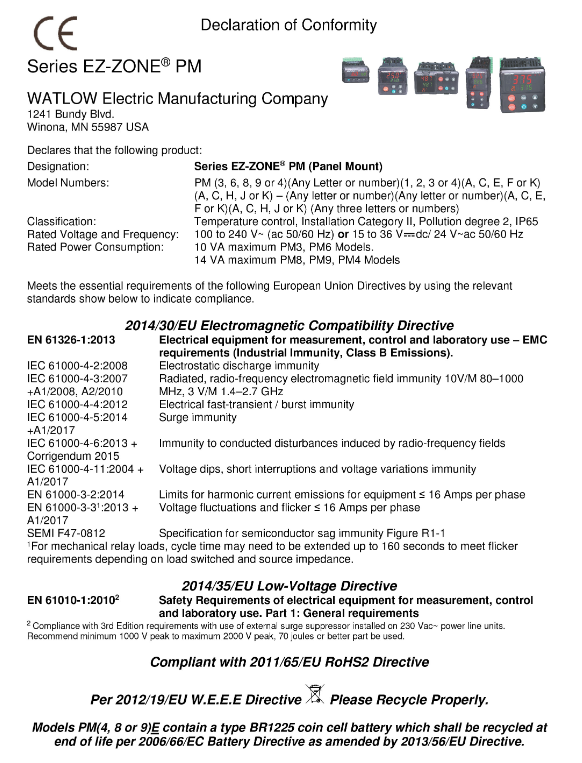Watlow PM PLUS ™ 6 Series PID Integrated Controller
(2) Alarm troubleshooting process
Alarm recognition: The main screen alternately displays alarm information (such as "Alarm High 1"), path → Operations → Alarm → Alarm 1 → Alarm State to view detailed status (such as "High").
Root cause analysis:
If it is "Alarm High": Check whether the process value exceeds the "High Set Point" and whether there is any abnormal load (such as continuous power on of the heater).
If it is an "Input Error": Check if the sensor wiring is loose and if the sensor is damaged (such as a broken thermocouple).
Treatment measures:
Process abnormality: troubleshoot the load (such as replacing the heater), and clear the alarm after the process value returns to the safe range (path → Alarm → Clear Alarm).
Sensor malfunction: Replace the sensor. If "Input Error Latching" is enabled, manually clear the error (path → Analog Input → Input Error Latching → Off, then switch back to On).

Typical application scenarios and configuration examples
1. Single loop temperature control (industrial oven)
demand
Control the oven temperature at 180 ° C ± 2 ° C, with a heating power of 10kW and a K-type thermocouple sensor. High alarm (200 ° C) and low alarm (160 ° C) are required.
Configuration steps
Input: Analog Input 1 → Sensor Type=Thermocouple, TC Linearization=K, Filter=1.0 seconds.
Output: Output 1 → Function=Heat, Type=NO-ARC Relay (15A), Fixed Time Base=5.0 seconds.
PID control: Heat Algorithm=PID, execute Auto Tune (target set point 180 ° C).
Alarm: Alarm 1 → Type=Process Alarm, High Set Point=200 ° C, Low Set Point=160 ° C, Hysteresis=2 ° C, Latching=Yes.
2. Sensor backup control (medical sterilization equipment)
demand
The sterilization temperature needs to be stable at 121 ° C. The main sensor is RTD (3-wire system), and the backup sensor is J-type thermocouple. When the main sensor fails, it will automatically switch to the backup sensor.
Configuration steps
Input:
Analog Input 1 (main) → Sensor Type=RTD, RTD Leads=3, Resistance Range=100 Ω.
Analog Input 2 (backup) → Sensor Type=Thermocouple, TC Linearization=J.
Path → Operations → Setup → Process Value → Function=Sensor Backup,Source Function A=Analog Input 1,Source Function B=Analog Input 2。
Output: Output 1 → Function=Heat, Type=SSR (0.5A), drives an external solid-state relay to control the heating tube.
Limit protection: Limit 1 → High Set Point=130 ° C, Low Set Point=110 ° C, Reset Source=Digital Input 5 (manual reset button).
3. Slope/constant temperature process (material heat treatment)
demand
Process curve: Room temperature → 100 ° C (heating for 30 minutes) → 100 ° C insulation for 60 minutes → 150 ° C (heating for 20 minutes) → 150 ° C insulation for 120 minutes → cooling to 50 ° C (cooling for 40 minutes).
Configuration steps
Global settings: Ramp Type=Time, Guaranteed Soak Enable=Yes, Guaranteed Soak Dev. 1=1 ° C.
Program editor:
Step 1: Time type, Target=100 ° C, Time=30 minutes.
Step 2: Soak type, Time=60 minutes.
Step 3: Time type, Target=150 ° C, Time=20 minutes.
Step 4: Soak type, Time=120 minutes.
Step 5: Time type, Target=50 ° C, Time=40 minutes.
Step 6: End Type, End Type=Off (shutdown after cooling down).
Startup method: Function Key is configured as "Profile Start" to start the program with one click.
Appendix Key Information
1. Configuration code analysis
14 bit configuration code defines the hardware and functional options of the controller, for example: PM6C2CAEAALFJWP
Explanation of Example Values for Rank Meaning
1-2 Product Series PM=PM PLUS ™ series
3 package size 6=1/16 DIN
4 core functions C=PID controller with universal input
5 power supply and I/O 2=100-240VAC+2 digital I/O channels
6-7 output 1/2 CA=Output1=DC switch, Output2=None
8 Communication options E=EIA-485 Modbus ® RTU+Bluetooth
9 Auxiliary Function A=None
10-11 output 3/4 LJ=Output3=None, Output4=Mechanical Relay (Form A)
12 model selection F=Enhanced firmware (including ratio/difference control)
13-14 Custom Options WP=Front Panel with Watlow Logo
2. Compliance Statement
CE Compliance: Compliant with the 2014/30/EU (EMC), 2014/35/EU (low voltage), and 2014/53/EU (wireless, Bluetooth models) directives.
Dangerous area: Class 1, Div. 2 models must meet the ANSI/ISA 12.12.01-2007 standard, temperature code T4A, and cannot be used in Class 1, Div. 1 areas.
RoHS/WEEE: Complies with the 2011/65/EU RoHS 2 directive, and must be recycled according to local regulations when discarded (including button batteries, which need to be recycled separately).

- EMERSON
- Honeywell
- CTI
- Rolls-Royce
- General Electric
- Woodward
- Yaskawa
- xYCOM
- Motorola
- Siemens
- Rockwell
- ABB
- B&R
- HIMA
- Construction site
- electricity
- Automobile market
- PLC
- DCS
- Motor drivers
- VSD
- Implications
- cement
- CO2
- CEM
- methane
- Artificial intelligence
- Titanic
- Solar energy
- Hydrogen fuel cell
- Hydrogen and fuel cells
- Hydrogen and oxygen fuel cells
- tyre
- Chemical fiber
- dynamo
- corpuscle
- Pulp and paper
- printing
- fossil
- FANUC
- Food and beverage
- Life science
- Sewage treatment
- Personal care
- electricity
- boats
- infrastructure
- Automobile industry
- metallurgy
- Nuclear power generation
- Geothermal power generation
- Water and wastewater
- Infrastructure construction
- Mine hazard
- steel
- papermaking
- Natural gas industry
- Infrastructure construction
- Power and energy
- Rubber and plastic
- Renewable energy
- pharmacy
- mining
- Plastic industry
- Schneider
- Kongsberg
- NI
- Wind energy
- International petroleum
- International new energy network
- gas
- WATLOW
- ProSoft
- SEW
- wind
- ADVANCED
- Reliance
- YOKOGAWA
- TRICONEX
- FOXBORO
- METSO
- MAN
- Advantest
- ADVANCED
- ALSTOM
- Control Wave
- AB
- AMAT
- STUDER
- KONGSBERG
- MOTOROLA
- DANAHER MOTION
- Bently
- Galil
- EATON
- MOLEX
- Triconex
- DEIF
- B&W
- ZYGO
- Aerotech
- DANFOSS
- KOLLMORGEN
- Beijer
- Endress+Hauser
- MOOG
- KB
- Moxa
- Rexroth
- YAMAHA
- Johnson
- Westinghouse


Email:wang@kongjiangauto.com































































































































